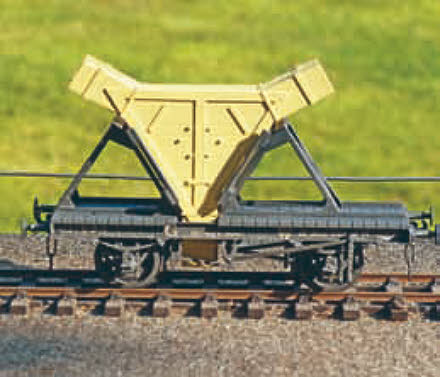GWR Aero (Aircraft propeller wagon) kit Dia. E4
Purchased and Reviewed by Mark Horley
Gazette - August 2016 (Vol 19 No.12)
| Failed to open database: gaugegu1_gog2 | ret is false |
I bought this kit from the Haywood stand at Telford a few
years ago as it offered an unusual wagon. I believe the
prototype wagons were conversions in the late 1930s from
Roll wagons and were intended to carry Wellington bomber
propellers. It came as a flat pack in a slim plastic A4 sized box
with the wheels handed over in a plastic bag. Inside the box
was a CD-ROM, four small sheet of etches, two white-metal
castings for the trestle parts and packets of sprung buffers,
sprung axle boxes and couplings.
The CD-ROM provides the instructions, a price list and some
notes on construction techniques. Not wishing to have the
computer next to the work area I had to print off the
instructions after editing them down to a reasonable size. As
written, the assembly instructions comprise notes of each
stage of construction along with pictures of each etched
component in the flat, folded and then soldered to the wagon
The two floor and solebar units both involve some complex
folding along half etched lines. The floor unit in particular
requires long narrow edges to be bent down on all four sides
which makes the task fiddly even with bending bars. I had to
do a little fettling of the components to get them to fit
together smoothly as they were a tight fit. The instructions
suggest using 2BA screws through the buffer holes to aid
assembly alignment. This is a useful tip but I found 4BA more
appropriate.
The trestles are each formed origami like from a single
delicate etch which requires detaching with care from the
surrounding metal to avoid distortion. I ran a triangular file
along the fold lines to ease the bending. White-metal castings
for the crate supports, which did not seem to be mentioned in
the instructions, are mounted on the inner face of each trestle.
The W-irons are etched as pairs with a bridging section. The
bridging section has four slots that engage with tabs
previously folded down from the solebars. I had to trim the
inner edges of these tabs to achieve a fit. The etched brake
gear, safety loops and levers were then added, completing the
etched brass assembly. At this stage I soldered in the white
metal buffers. The wagon was then prepared for painting by
cleaning with a fibre glass pencil and then thoroughly washing
with a kitchen cleaner and plenty of water. Grey car primer was
sprayed on using an aerosol can and followed by two thin
coats of Precision Paints wagon grey, again from an aerosol.
After applying transfers I then lightly airbrushed the wagon
with a weathering mix.
White-metal axle boxes slide in the W-irons with keeper
plates to hold them in place. As suggested in the instructions I
fitted the wheels, axle boxes and springs after
painting. I opened up the cast slots in the axle
boxes with a junior hacksaw so the axleboxes
slid freely and I also had to open up the holes in
the top of the axleboxes that locate the springs with a drill. The bottom of the
W-irons bend backwards to stop the axleboxes slipping out while the
keeper plate is soldered across the opening.
I decided that I wanted my wagon to be complete with two crated aircraft propellers. GWR Goods Wagons by
A.G.Atkins, W Beard & R Tourret (Published 1998 by Tourret publishing. ISBN 0-905878-07-8) has a drawing of
the wagon with an outline of the crate as well as photographs of the loaded wagon
on page 142. Further photographs can be found in Railways in Profile series No.15 GWR
Wagons Before 1948 Vol.1 Compiled by R Tourret (Published by
Cheona Publications in 2005. ISBN 1 900298 29 5) and GWR
Freight Wagons & Loads by J H Russell (Published 1981 ISBN 0
86093 1552).
I constructed crates from Plastikard using the drawing to get
basic dimensions and the photographs to complete the detail.
A plain carcass was first built about 1mm smaller than the
overall dimensions. Slaters planked sheet was then glued on
to create the box with a triangular centre section of each side
and three oblongs to cover the ‘ears.’ Thin strips were then
added to represent the reinforcements which conveniently
cover the joints between the Plastikard planked sheets. The
prominent bolt heads around the centre of the crate were
short lengths of rod glued on and gently sanded down to an
even height. Panting was with Humbrol light oak with some
dirty thinners run into the plank grooves to emphasis the
detail. The two containers are held in the cradles by gravity as
I have not found any photographic evidence of any fastenings.
To summarise the wagon fitted together well with tab and
slot construction locating the components. I would say the kit
is suitable for anyone with previous experience of solder
assembly of etched brass kits.
Geoff Gill, Haywood’s proprietor has seen a copy of this review. He found it a fair review and couldn’t think of anything he wished to add. He advised that they were in the process of updating a number of their kits, hopefully in time for this year’s Guildex.






